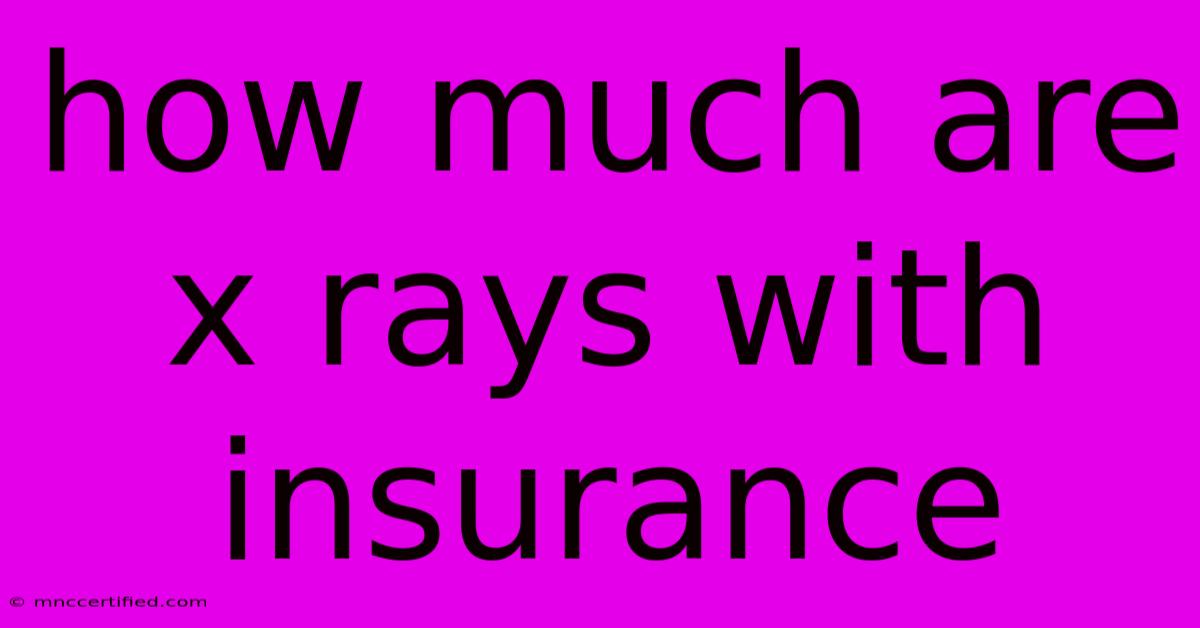How Much Are X Rays With Insurance

Table of Contents
How Much Are X-Rays With Insurance? A Comprehensive Guide
The cost of X-rays can vary significantly, even with insurance. Understanding your coverage and potential out-of-pocket expenses is crucial before undergoing any medical imaging. This guide breaks down the factors influencing the price of X-rays with insurance, helping you navigate the process and prepare for potential costs.
Factors Affecting X-Ray Costs With Insurance
Several factors determine the final cost of an X-ray, even when you have insurance:
1. Type of X-Ray:
The specific type of X-ray significantly impacts the price. A simple chest X-ray is generally less expensive than a more complex procedure like a dental panoramic X-ray or a specialized bone X-ray. Different procedures have different billing codes, impacting your copay and out-of-pocket expenses.
2. Your Insurance Plan:
Your insurance plan's coverage plays a crucial role. Key factors include:
- Copay: This is a fixed amount you pay each time you receive a covered service.
- Coinsurance: This is the percentage of the cost you pay after meeting your deductible.
- Deductible: The amount you must pay out-of-pocket before your insurance begins covering services.
- Network Providers: Using in-network providers typically results in lower costs than out-of-network providers. Always verify if your imaging center is in your insurance network.
- Plan Type: HMOs, PPOs, and POS plans all have different cost-sharing structures.
3. The Healthcare Provider:
The location and type of healthcare provider also affect pricing. Hospital-based imaging centers tend to have higher costs compared to independent radiology clinics or urgent care facilities. Geographic location can also influence prices.
4. Additional Services:
Any additional services, such as consultations with a radiologist to review the images or contrast dye used during the procedure, will add to the total cost.
Estimating Your Costs: Before Your Appointment
Before scheduling your X-ray, take proactive steps to estimate your potential costs:
- Contact your insurance provider: Call your insurance company to confirm your coverage for X-rays. Inquire about your copay, coinsurance, deductible, and whether the facility is in-network. Obtain the specific billing codes for the type of X-ray you need. This information will give you the best estimate of your costs.
- Check the provider's website: Many imaging centers provide estimated pricing information on their websites. However, this might not include the insurance aspects.
- Ask the provider directly: Call the imaging center or your doctor's office to inquire about the cost of the X-ray and the billing process.
Navigating Unexpected Costs:
Even with insurance, unexpected costs can arise. Be prepared for potential scenarios like:
- Higher-than-expected copay or coinsurance: Your insurance may cover a portion of the cost, but your share could be higher than anticipated.
- Out-of-network charges: Using an out-of-network provider will drastically increase your out-of-pocket expenses.
- Additional fees: Unforeseen additional fees, such as for contrast dye or interpretation of results, can add to the total cost.
Minimizing Your X-Ray Costs:
Consider these strategies to minimize your expenses:
- Use in-network providers: This will significantly reduce your out-of-pocket costs.
- Check for discounts: Some providers offer discounts for cash payments or specific payment methods.
- Explore financial assistance options: If you face financial hardship, inquire about payment plans or financial assistance programs offered by the healthcare provider or your insurance company.
Conclusion: Proactive Planning is Key
The cost of X-rays with insurance isn't fixed. By understanding the factors that influence pricing and taking proactive steps to estimate your costs and maximize your insurance coverage, you can better manage your healthcare expenses. Remember, open communication with your insurance provider and the healthcare facility is crucial for navigating the process smoothly.

Thank you for visiting our website wich cover about How Much Are X Rays With Insurance. We hope the information provided has been useful to you. Feel free to contact us if you have any questions or need further assistance. See you next time and dont miss to bookmark.
Featured Posts
-
Argentina Loses To Paraguay In World Cup Qualifier
Nov 15, 2024
-
Alex Jones Rants After Infowars Sale
Nov 15, 2024
-
Tate Mc Rae Gears Up For 2025 Tour
Nov 15, 2024
-
Brazil Vs Venezuela Fifa World Cup 2026 Updates
Nov 15, 2024
-
Usmnt Wins First Leg Against Jamaica
Nov 15, 2024